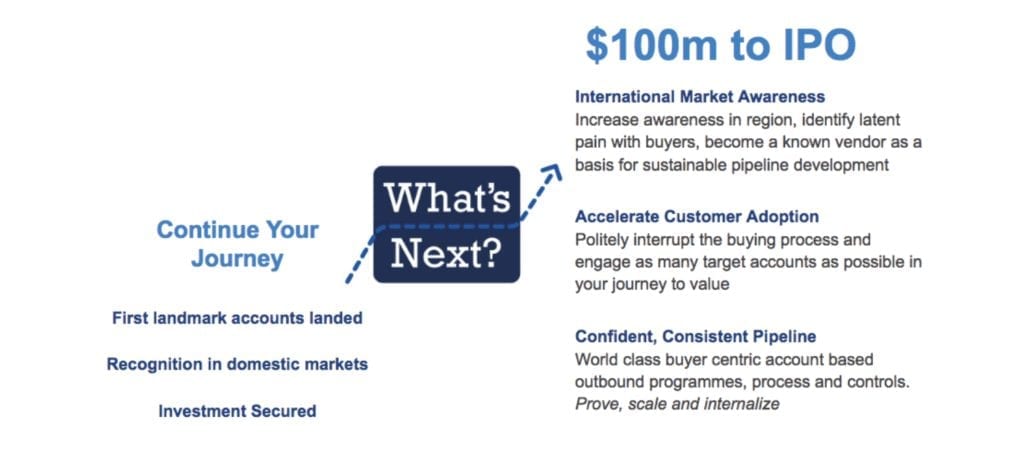
By Craig Hooper, CEO and Co-Founder of DWCC
Going international is a critical step in your B2B journey from $0 to $100m, but the path is rarely a simple one, with most projects facing significant hurdles, false starts, and restarts along the way.
Considering this, here are my top 5 actionable insights about how to make this journey run as smoothly as possible:
1. Manage expectations
Things move fast in this industry, but you have to be realistic about the maturity of the market, your buyer, and your offerings. Ansoff’s Product-Market Growth Matrix is as relevant for SaaS companies entering new markets today as it was for big corporations in the 50s and 60s. It’s vital that you appreciate where you are now and manage pipeline expectations accordingly:
- Market Testing: During the education phase, it is crucial to measure the relevance/resonance of your value proposition and your Meaningful Interaction to Qualified Lead Conversion.
- Market Development: The market is aware of the issues and how you may be able to help them—now the focus is on Discovery Call to Opportunity Conversion. You have their ear, but can you create the urgency to get them moving?
- Market Penetration: The market it hot—now it is all about Net New Pipeline Creation and Close Won/Loss Conversion. How do you qualify well, maintain focus on value, control the close, and maximize win rates?
2. Relentless buyer centricity
I cannot overstate the importance of this—for consistent growth over $10m ARR, you need to focus on the buyer’s critical business issues and value, not on yourself or your product features.
- At the beginning of the process your buyer does not care about your funding, awards, or algorithms—this comes later and can be a risk too early in process. It is essential that you focus on the buyer’s critical business issues and associate your solution with addressing those problems for your champion. It really is straightforward: the bigger the problem you solve, the bigger the deals you can close—and at a higher price point.
- Enterprise decision-making processes are complex. Landing the initial Proof Of Concept deal is great, but developing a Current State/Desired State strategy and quickly identifying your key influencers, stakeholders, champions, and the economic buyer is key to increasing POC success and ARR. To remove the risk of hitting a dead end, you need to be a known vendor within the account.
3. Stand on your customers’ shoulders
Leverage your enterprise success stories for high-impact storytelling.
- The chances are good that your ideal buyers won’t have heard of you, but they will know your customers, and this is the key to standing out in a noisy space. Appreciate that you’re not just competing with other vendors, but also internal workloads, priorities, and the perceived risk of your initiative’s success.
- A relevant use case builds trust with a prospect and provides proof that you have done this before, in a similar environment. Be proud of your enterprise logos and look to repeat the success stories early on in the buying cycle—repeat delivery of value is the key. Talk business, not software!
4. Think global, act local
It is almost impossible to execute a world-class international expansion from another region.
- Appreciate the business cultures in each market. Your USA SDR Team is awesome, but don’t assume that this will translate well into other markets. Think about the most appropriate way to engage with your audience, what time zones, languages, and channels, and how direct or contextual they are with their communication. You need to maintain professional persistence to nail these buyers down.
- Local nuances are subtle but have a huge impact in those crucial moments, such as the first few seconds of a phone call or the reading of an email subject line. This cannot be learned overnight, so you will have to ensure you have the necessary expertise to get your international playbooks correct out of the gate.
5. Prioritize international
We know this is important. It may feel too big, too scary, too risky… but do not get paralyzed. Appreciate the risk, but do not obsess about it. Go ahead and test the market!
- The clock is ticking—you have a limited window of opportunity to quickly make an impact in your market and affect decision making in your ideal accounts, so get the focused outbound program up and running, be disruptive, start talking to your buyers, and get past your first 100 customers!
- Control your risk through agile focused outbound sprints. The meaningful interactions will be the most important guidance you will get, and—provided you have a relevant value proposition that gets prospects to sit up and listen—you can immediately start influencing their thought process and politely disrupt their buying process.
The above points are synthesized from discussions over the last decade with over 500 B2B enterprise SaaS executives as well as the experience of working on over 80 international launches. I hope they provide some useful areas to think about and act as guidance while you look to take (or continue taking) this crucial step in your journey.
I am very fortunate to sit over a great international team who have learned their lessons and built up a well of experience to deliver this day in and day out. We are proud and excited to be sponsoring the inaugural SaaStr Europa event this month, and hope to see you in Paris to talk more about some of the topics above.

